2007 CHEVROLET HHR stop start
[x] Cancel search: stop startPage 11 of 446
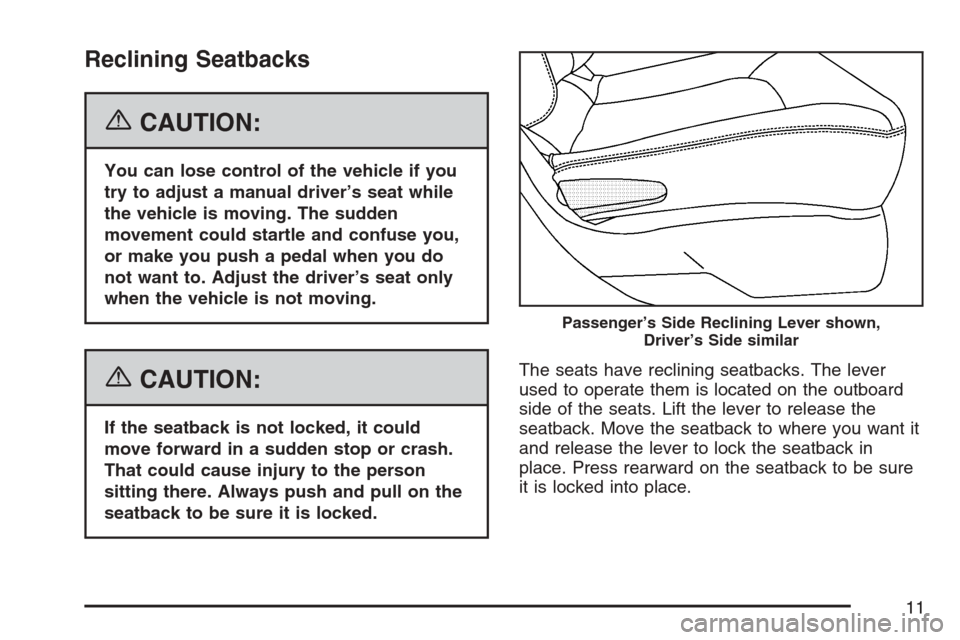
Reclining Seatbacks
{CAUTION:
You can lose control of the vehicle if you
try to adjust a manual driver’s seat while
the vehicle is moving. The sudden
movement could startle and confuse you,
or make you push a pedal when you do
not want to. Adjust the driver’s seat only
when the vehicle is not moving.
{CAUTION:
If the seatback is not locked, it could
move forward in a sudden stop or crash.
That could cause injury to the person
sitting there. Always push and pull on the
seatback to be sure it is locked.The seats have reclining seatbacks. The lever
used to operate them is located on the outboard
side of the seats. Lift the lever to release the
seatback. Move the seatback to where you want it
and release the lever to lock the seatback in
place. Press rearward on the seatback to be sure
it is locked into place.
Passenger’s Side Reclining Lever shown,
Driver’s Side similar
11
Page 115 of 446
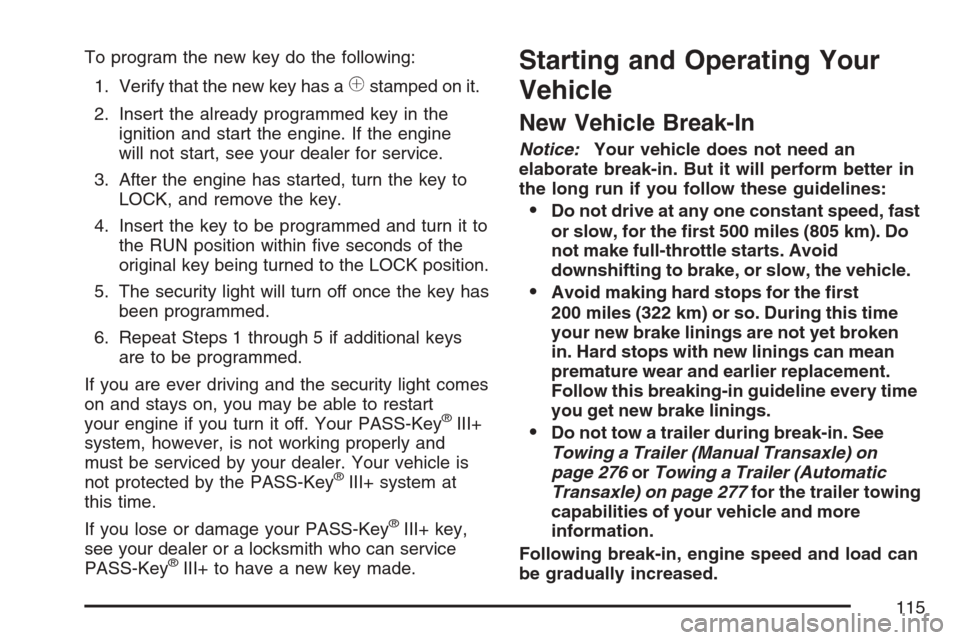
To program the new key do the following:
1. Verify that the new key has a
1stamped on it.
2. Insert the already programmed key in the
ignition and start the engine. If the engine
will not start, see your dealer for service.
3. After the engine has started, turn the key to
LOCK, and remove the key.
4. Insert the key to be programmed and turn it to
the RUN position within �ve seconds of the
original key being turned to the LOCK position.
5. The security light will turn off once the key has
been programmed.
6. Repeat Steps 1 through 5 if additional keys
are to be programmed.
If you are ever driving and the security light comes
on and stays on, you may be able to restart
your engine if you turn it off. Your PASS-Key
®III+
system, however, is not working properly and
must be serviced by your dealer. Your vehicle is
not protected by the PASS-Key
®III+ system at
this time.
If you lose or damage your PASS-Key
®III+ key,
see your dealer or a locksmith who can service
PASS-Key
®III+ to have a new key made.
Starting and Operating Your
Vehicle
New Vehicle Break-In
Notice:Your vehicle does not need an
elaborate break-in. But it will perform better in
the long run if you follow these guidelines:
Do not drive at any one constant speed, fast
or slow, for the �rst 500 miles (805 km). Do
not make full-throttle starts. Avoid
downshifting to brake, or slow, the vehicle.
Avoid making hard stops for the �rst
200 miles (322 km) or so. During this time
your new brake linings are not yet broken
in. Hard stops with new linings can mean
premature wear and earlier replacement.
Follow this breaking-in guideline every time
you get new brake linings.
Do not tow a trailer during break-in. See
Towing a Trailer (Manual Transaxle) on
page 276orTowing a Trailer (Automatic
Transaxle) on page 277for the trailer towing
capabilities of your vehicle and more
information.
Following break-in, engine speed and load can
be gradually increased.
115
Page 119 of 446
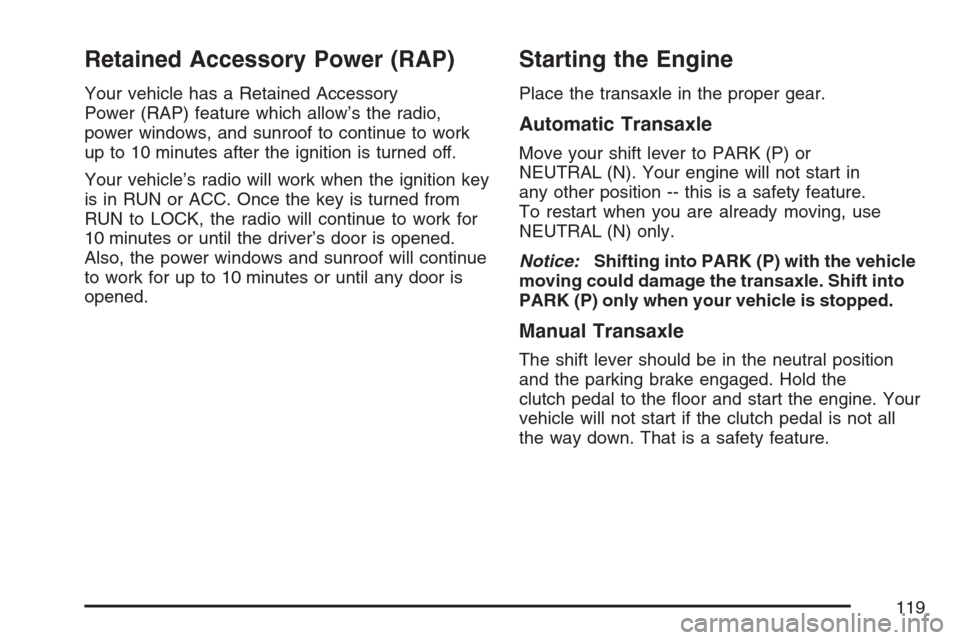
Retained Accessory Power (RAP)
Your vehicle has a Retained Accessory
Power (RAP) feature which allow’s the radio,
power windows, and sunroof to continue to work
up to 10 minutes after the ignition is turned off.
Your vehicle’s radio will work when the ignition key
is in RUN or ACC. Once the key is turned from
RUN to LOCK, the radio will continue to work for
10 minutes or until the driver’s door is opened.
Also, the power windows and sunroof will continue
to work for up to 10 minutes or until any door is
opened.
Starting the Engine
Place the transaxle in the proper gear.
Automatic Transaxle
Move your shift lever to PARK (P) or
NEUTRAL (N). Your engine will not start in
any other position -- this is a safety feature.
To restart when you are already moving, use
NEUTRAL (N) only.
Notice:Shifting into PARK (P) with the vehicle
moving could damage the transaxle. Shift into
PARK (P) only when your vehicle is stopped.
Manual Transaxle
The shift lever should be in the neutral position
and the parking brake engaged. Hold the
clutch pedal to the �oor and start the engine. Your
vehicle will not start if the clutch pedal is not all
the way down. That is a safety feature.
119
Page 120 of 446
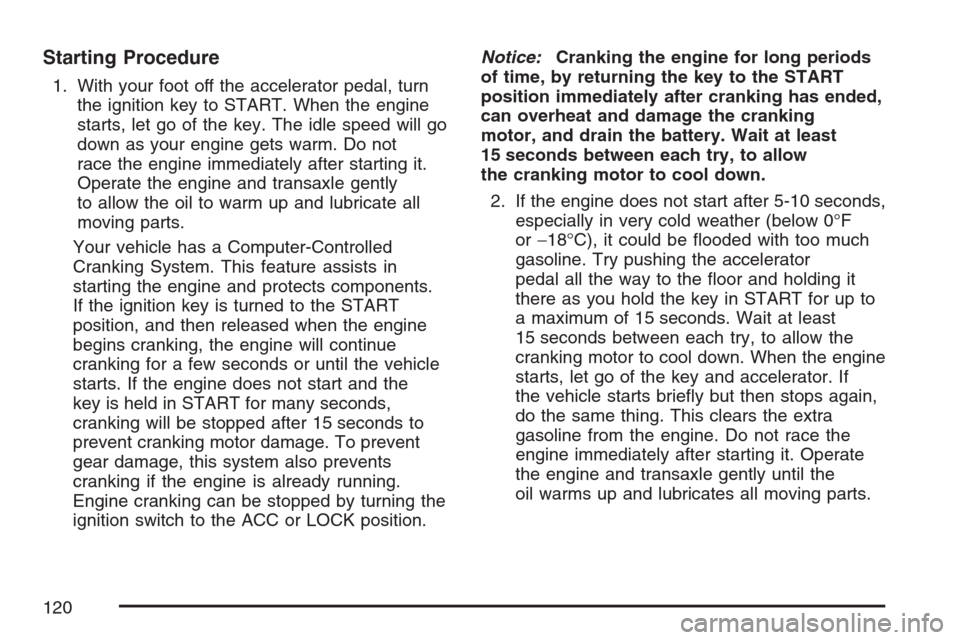
Starting Procedure
1. With your foot off the accelerator pedal, turn
the ignition key to START. When the engine
starts, let go of the key. The idle speed will go
down as your engine gets warm. Do not
race the engine immediately after starting it.
Operate the engine and transaxle gently
to allow the oil to warm up and lubricate all
moving parts.
Your vehicle has a Computer-Controlled
Cranking System. This feature assists in
starting the engine and protects components.
If the ignition key is turned to the START
position, and then released when the engine
begins cranking, the engine will continue
cranking for a few seconds or until the vehicle
starts. If the engine does not start and the
key is held in START for many seconds,
cranking will be stopped after 15 seconds to
prevent cranking motor damage. To prevent
gear damage, this system also prevents
cranking if the engine is already running.
Engine cranking can be stopped by turning the
ignition switch to the ACC or LOCK position.Notice:Cranking the engine for long periods
of time, by returning the key to the START
position immediately after cranking has ended,
can overheat and damage the cranking
motor, and drain the battery. Wait at least
15 seconds between each try, to allow
the cranking motor to cool down.
2. If the engine does not start after 5-10 seconds,
especially in very cold weather (below 0°F
or−18°C), it could be �ooded with too much
gasoline. Try pushing the accelerator
pedal all the way to the �oor and holding it
there as you hold the key in START for up to
a maximum of 15 seconds. Wait at least
15 seconds between each try, to allow the
cranking motor to cool down. When the engine
starts, let go of the key and accelerator. If
the vehicle starts brie�y but then stops again,
do the same thing. This clears the extra
gasoline from the engine. Do not race the
engine immediately after starting it. Operate
the engine and transaxle gently until the
oil warms up and lubricates all moving parts.
120
Page 123 of 446
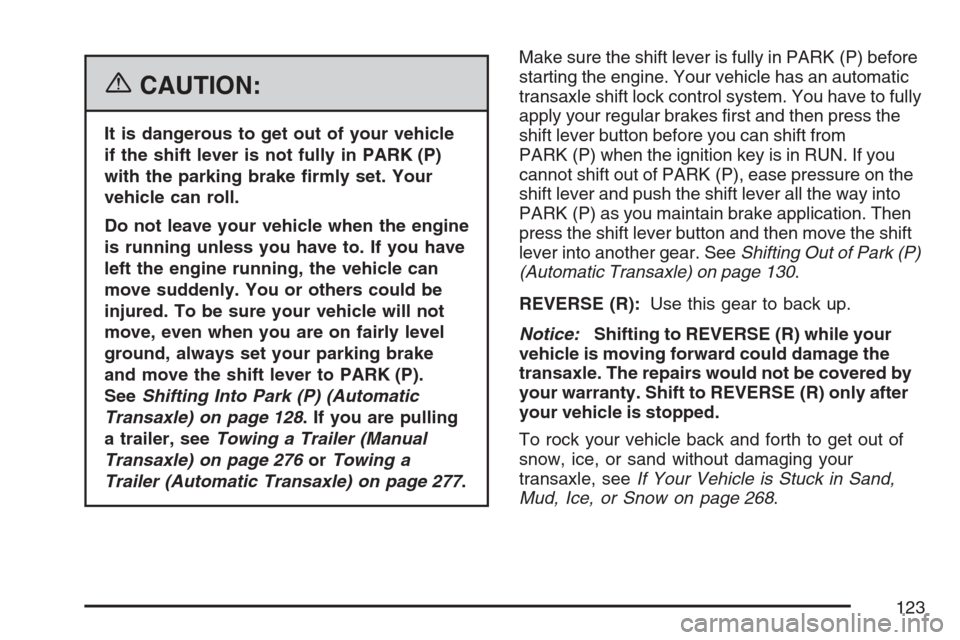
{CAUTION:
It is dangerous to get out of your vehicle
if the shift lever is not fully in PARK (P)
with the parking brake �rmly set. Your
vehicle can roll.
Do not leave your vehicle when the engine
is running unless you have to. If you have
left the engine running, the vehicle can
move suddenly. You or others could be
injured. To be sure your vehicle will not
move, even when you are on fairly level
ground, always set your parking brake
and move the shift lever to PARK (P).
SeeShifting Into Park (P) (Automatic
Transaxle) on page 128. If you are pulling
a trailer, seeTowing a Trailer (Manual
Transaxle) on page 276orTowing a
Trailer (Automatic Transaxle) on page 277.Make sure the shift lever is fully in PARK (P) before
starting the engine. Your vehicle has an automatic
transaxle shift lock control system. You have to fully
apply your regular brakes �rst and then press the
shift lever button before you can shift from
PARK (P) when the ignition key is in RUN. If you
cannot shift out of PARK (P), ease pressure on the
shift lever and push the shift lever all the way into
PARK (P) as you maintain brake application. Then
press the shift lever button and then move the shift
lever into another gear. SeeShifting Out of Park (P)
(Automatic Transaxle) on page 130.
REVERSE (R):Use this gear to back up.
Notice:Shifting to REVERSE (R) while your
vehicle is moving forward could damage the
transaxle. The repairs would not be covered by
your warranty. Shift to REVERSE (R) only after
your vehicle is stopped.
To rock your vehicle back and forth to get out of
snow, ice, or sand without damaging your
transaxle, seeIf Your Vehicle is Stuck in Sand,
Mud, Ice, or Snow on page 268.
123
Page 126 of 446
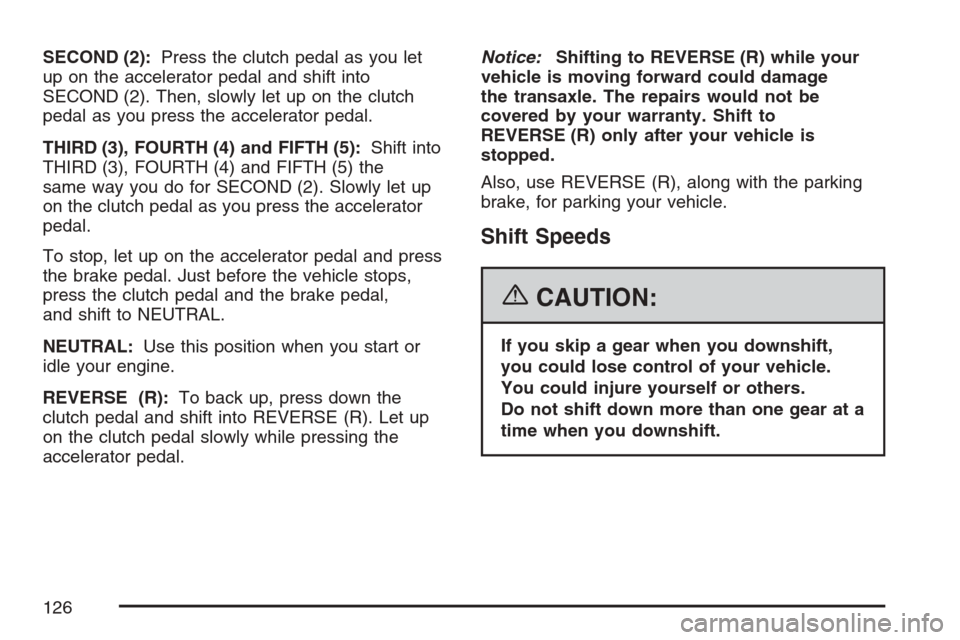
SECOND (2):Press the clutch pedal as you let
up on the accelerator pedal and shift into
SECOND (2). Then, slowly let up on the clutch
pedal as you press the accelerator pedal.
THIRD (3), FOURTH (4) and FIFTH (5):Shift into
THIRD (3), FOURTH (4) and FIFTH (5) the
same way you do for SECOND (2). Slowly let up
on the clutch pedal as you press the accelerator
pedal.
To stop, let up on the accelerator pedal and press
the brake pedal. Just before the vehicle stops,
press the clutch pedal and the brake pedal,
and shift to NEUTRAL.
NEUTRAL:Use this position when you start or
idle your engine.
REVERSE (R):To back up, press down the
clutch pedal and shift into REVERSE (R). Let up
on the clutch pedal slowly while pressing the
accelerator pedal.Notice:Shifting to REVERSE (R) while your
vehicle is moving forward could damage
the transaxle. The repairs would not be
covered by your warranty. Shift to
REVERSE (R) only after your vehicle is
stopped.
Also, use REVERSE (R), along with the parking
brake, for parking your vehicle.
Shift Speeds
{CAUTION:
If you skip a gear when you downshift,
you could lose control of your vehicle.
You could injure yourself or others.
Do not shift down more than one gear at a
time when you downshift.
126
Page 147 of 446
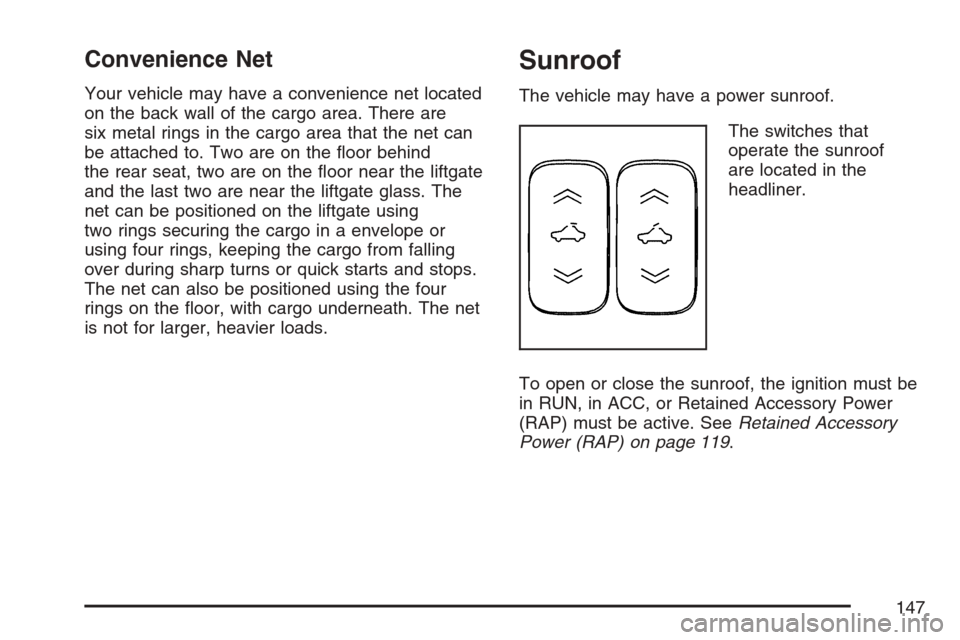
Convenience Net
Your vehicle may have a convenience net located
on the back wall of the cargo area. There are
six metal rings in the cargo area that the net can
be attached to. Two are on the �oor behind
the rear seat, two are on the �oor near the liftgate
and the last two are near the liftgate glass. The
net can be positioned on the liftgate using
two rings securing the cargo in a envelope or
using four rings, keeping the cargo from falling
over during sharp turns or quick starts and stops.
The net can also be positioned using the four
rings on the �oor, with cargo underneath. The net
is not for larger, heavier loads.
Sunroof
The vehicle may have a power sunroof.
The switches that
operate the sunroof
are located in the
headliner.
To open or close the sunroof, the ignition must be
in RUN, in ACC, or Retained Accessory Power
(RAP) must be active. SeeRetained Accessory
Power (RAP) on page 119.
147
Page 186 of 446
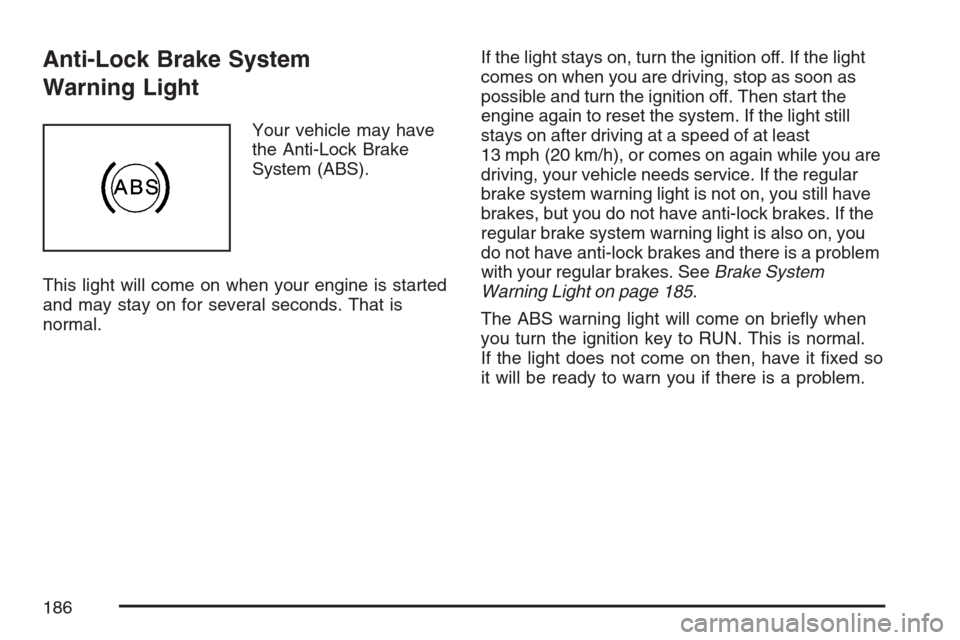
Anti-Lock Brake System
Warning Light
Your vehicle may have
the Anti-Lock Brake
System (ABS).
This light will come on when your engine is started
and may stay on for several seconds. That is
normal.If the light stays on, turn the ignition off. If the light
comes on when you are driving, stop as soon as
possible and turn the ignition off. Then start the
engine again to reset the system. If the light still
stays on after driving at a speed of at least
13 mph (20 km/h), or comes on again while you are
driving, your vehicle needs service. If the regular
brake system warning light is not on, you still have
brakes, but you do not have anti-lock brakes. If the
regular brake system warning light is also on, you
do not have anti-lock brakes and there is a problem
with your regular brakes. SeeBrake System
Warning Light on page 185.
The ABS warning light will come on brie�y when
you turn the ignition key to RUN. This is normal.
If the light does not come on then, have it �xed so
it will be ready to warn you if there is a problem.
186